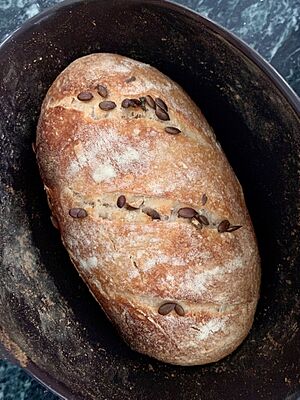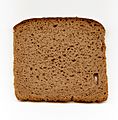List of sourdough breads facts for kids
Sourdough bread is a special type of bread made using a natural process called fermentation. Instead of using regular yeast packets, it uses a mix of wild yeast and good bacteria called lactobacilli that are already found in the air and flour. This mix is called a "sourdough starter."
The lactobacilli create lactic acid, which gives sourdough its unique slightly sour taste. This acid also helps the bread stay fresh longer than other breads. Many people love baking sourdough today! They often share their starters and baking tips online, and show off their delicious creations on social media.
Cool Sourdough Breads from Around the World
Sourdough is used to make many different kinds of bread all over the world. Here are some examples:
- Amish friendship bread: This is a sweet bread that starts with a sourdough starter. It's often shared with friends, who then keep the starter going and bake their own bread. It's a fun way to share baking!
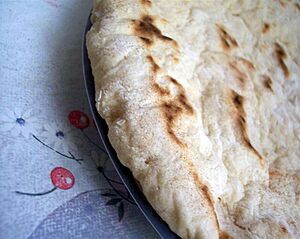
A fresh Bazlama flatbread
- Bazlama: This is a flat, round, unleavened bread from Turkey. It's usually baked on a hot griddle or in a stone oven. It's soft and often eaten with butter or cheese.
- Borodinsky bread: This dark brown bread comes from Russia. It's known for its strong, slightly sweet and sour taste, often flavored with coriander. It's a very traditional and hearty bread.
- Butterbrot: This is a simple German sandwich. It's usually just a slice of bread (often sourdough or rye bread) with butter. Sometimes it has cheese or cold cuts on top.
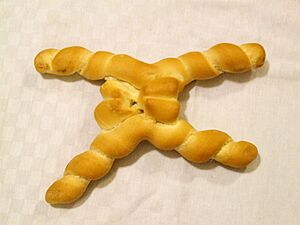
The unique shape of Coppia ferrarese bread
- Coppia ferrarese: This bread comes from Ferrara, Italy. It has a very unique twisted shape that looks like two crossed horns. It's a traditional bread with a protected status.
- Eish merahrah: This is a soft, thick flatbread from Egypt. It's made with corn flour and a sourdough starter. It's a staple food in many Egyptian homes.
- Eish shamsi: Another Egyptian bread, this one is made from wheat flour and a sourdough starter. Its name means "sun bread" because it's traditionally left to rise in the sun.
- Herman cake: This is a "friendship cake" that uses a sourdough starter, similar to Amish friendship bread. You feed the starter over several days, then bake a cake and share parts of the starter with others.
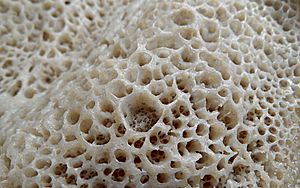
Ethiopian injera with its typical spongy texture
- Injera: This is a spongy, slightly sour flatbread from Ethiopia and Eritrea. It's made from teff flour and is a main part of meals, used to scoop up stews and other dishes.
- Kommissbrot: This is a dark, dense rye bread from Germany. It was traditionally baked for soldiers (Kommiss means "commissary" or "rations"). It's very filling and stays fresh for a long time.
- Maltese bread: Known as Ħobż tal-Malti, this is a traditional sourdough bread from Malta. It has a thick, crunchy crust and a soft, airy inside. It's a very popular everyday bread on the island.
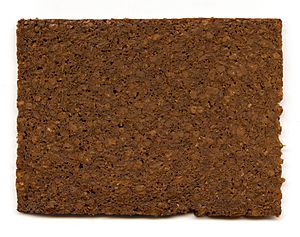
A slice of dark pumpernickel bread
- Pumpernickel: This is a very dark, dense, and slightly sweet rye bread that comes from Germany. It's often baked for a very long time at low temperatures, which gives it its unique color and flavor.
- Rugbrød: This is a very common type of rye bread from Denmark. It usually looks like a long, brown rectangle. It's made mostly from rye flour and often contains whole grains like cracked rye kernels, and sometimes seeds like sunflower, flax, or pumpkin seeds. It's a very hearty and healthy bread.
Images for kids
Learn More About Sourdough
- Carl Griffith's sourdough starter
- Desem
- Herculaneum loaf
- List of breads
- The Puratos Sourdough Library – This is a special place in the world that collects and keeps different sourdough starters alive. It's like a library, but for bread cultures!

All content from Kiddle encyclopedia articles (including the article images and facts) can be freely used under Attribution-ShareAlike license, unless stated otherwise. Cite this article:
List of sourdough breads Facts for Kids. Kiddle Encyclopedia.

